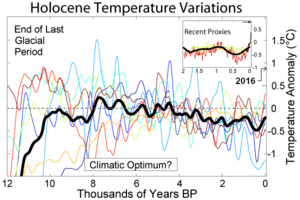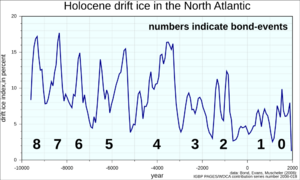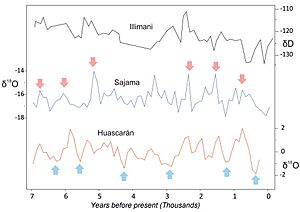Bond event facts for kids
Bond events are times when large chunks of ice broke off from glaciers and ice sheets in the North Atlantic Ocean. These events are thought to be connected to changes in Earth's climate during the Holocene period, which is the last 11,700 years of Earth's history. Scientists have found eight of these events so far. At first, it was thought that Bond events happened every 1,500 years. However, newer research suggests they might happen closer to every 1,000 years.
A scientist named Gerard C. Bond from Columbia University was the main author of a paper in 1997. This paper suggested that climate cycles of about 1,470 years happened in the past. This idea was based on clues from rocks found in the North Atlantic, which were carried by floating ice. But later studies at one location suggested that these rock clues weren't strong enough to prove a 1,500-year cycle. They thought the pattern might have just been a coincidence.
Also, after new information from the North GRIP ice core in Greenland came out in 2005, it became clear that other big climate changes, called Dansgaard–Oeschger events, don't show a 1,500-year pattern either. Interestingly, these North Atlantic ice-rafting events seem to match times when lake levels were low in the central United States. They also match the weakest Asian monsoon periods for the last 9,000 years. And they line up with most of the dry periods in the Middle East over the last 55,000 years, including both Heinrich events and Bond events.
What are Bond Events?
Most Bond events don't have a very clear climate signal. Some of them happened during cooler periods. But others happened when certain regions became very dry. The time between these events has been estimated to be between 1,000 and 1,500 years. Bond event #4 is a bit different from the others in terms of timing.
| No | Time (BP) |
Time (AD, BC) |
Gap from previous event | Notes |
|---|---|---|---|---|
| 0 | ≈ −0.5 ka | ≈ 1500 AD | 900 years | This event is linked to the Little Ice Age, a cooler period. |
| 1 | ≈ −1.4 ka | ≈ 600 AD | 1400 years | Happened around the Migration Period and the Late Antique Little Ice Age. |
| 2 | ≈ −2.8 ka | ≈ 800 BC | 1400 years | Corresponds to the Iron Age Cold Epoch, a colder time. |
| 3 | ≈ −4.2 ka | ≈ 2200 BC | 1700 years | Known as the 4.2-kiloyear event. It's linked to the fall of the Akkadian Empire and the end of the Egyptian Old Kingdom. |
| 4 | ≈ −5.9 ka | ≈ 3900 BC | 2300 years | The Sahara desert became dry again around 3500–3000 BC, ending a wet period. Also linked to the Piora Oscillation. The early Bronze Age began around 3300 BC. |
| 5 | ≈ −8.2 ka | ≈ 6200 BC | 1200 years | This is the 8.2-kiloyear event, a sudden cold snap. |
| 6 | ≈ −9.4 ka | ≈ 7400 BC | 1100 years | Linked to glacier growth in Norway (Erdalen event) and a cold period in China. |
| 7 | ≈ −10.3 ka | ≈ 8300 BC | 800 years | |
| 8 | ≈ −11.1 ka | ≈ 9100 BC | --- | This event marks the change from the very cold Younger Dryas period to the warmer Boreal period. |
Bond Events Around the World
Bond events have been found in places far from the North Atlantic, like the central Andes mountains in South America. Scientists have looked at ice cores from the tops of Nevado Sajama, Nevado Huascarán, and Nevado Illimani. These ice cores show up to six Bond cycles during the middle and upper Holocene. These cycles happened around 6400, 5500, 3700, 2700, 1300, and 200 years ago. Each of these times showed a drop in temperature.
See also




